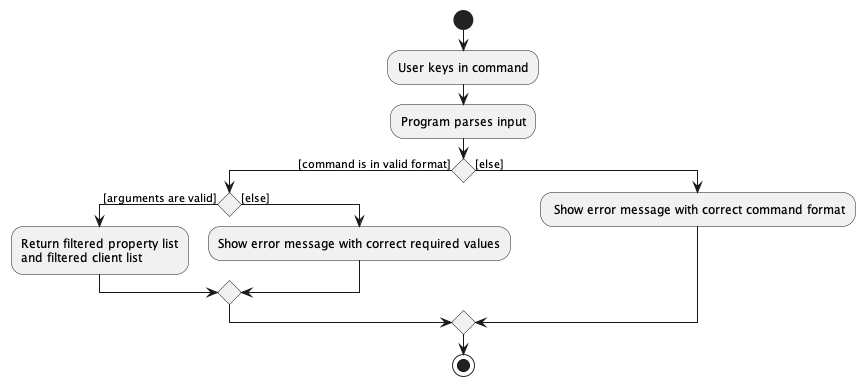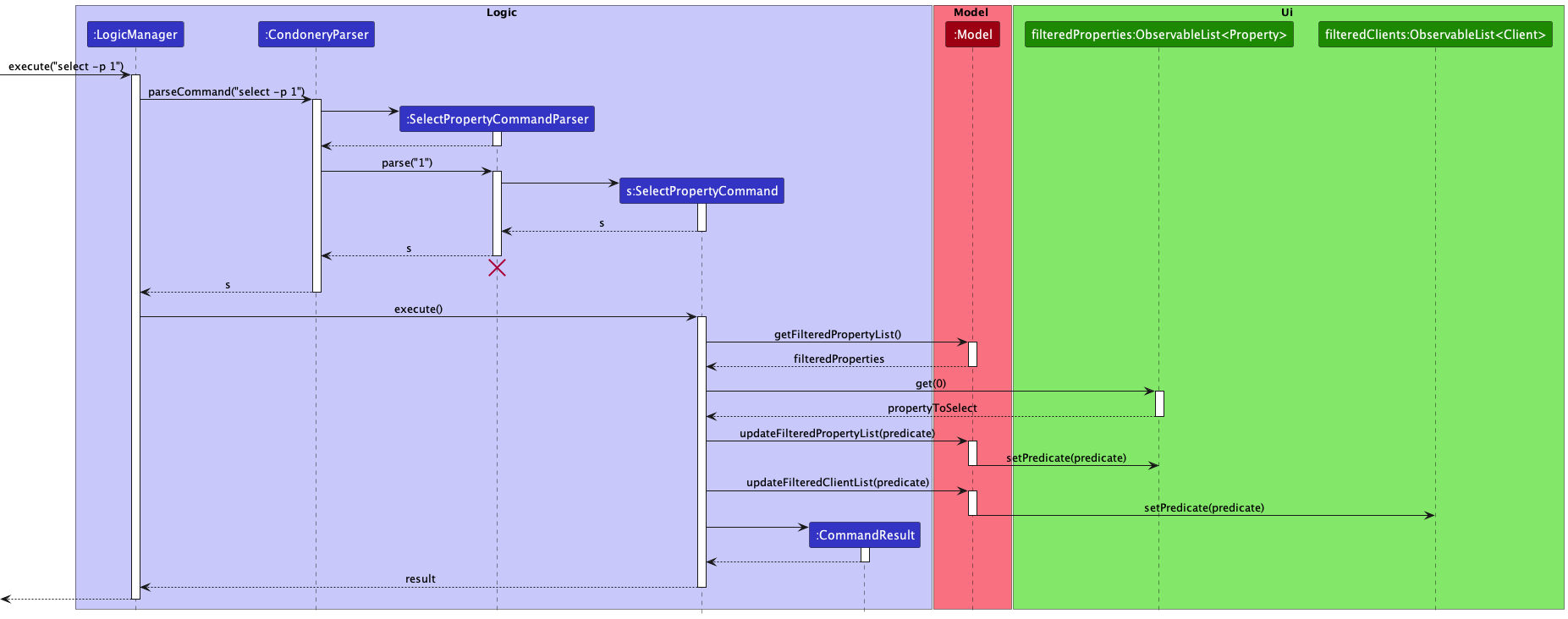Lee Kang Wei's Project Portfolio Page
Project: Condonery
Condonery is a desktop app made for property agents primarily used for managing client contacts and condo listings. It is optimized for use via a Command Line Interface (CLI) while still having the benefits of a Graphical User Interface (GUI). If you can type fast, Condonery can get your contact management tasks done faster than traditional GUI apps.
Given below are my contributions to the project.
- New Feature: Added the ability to select a single property or client, thus seeing its details as well as its interested clients or properties, respectively
- Users can add interested clients to a property, or interested properties to a client
- This feature faciliates easy viewing of a property’s interested clients, or a client’s interested properties
- As the select command changes the property list and client list on the GUI, it helps with workflows involving a property’s interested clients or a client’s interested properties
- For example, a user could submit a
select -p 1command to select the first displayed property, before submitting anedit -c 2command to edit that property’s second interested client
- For example, a user could submit a
- Code contributed:
- Enhancements implemented:
- Created the initial classes required for a Property
- Refactored commands into two subclasses:
PropertyCommandandClientCommand - Added the
interestedClientsattribute to thePropertyclass, and theinterestedPropertiesattribute to theClientclass
- Contibutions to User Guide:
- Added explanations for property and client attributes
- Includes each attribute’s associated prefix, which will be used in the
addandeditcommands
- Includes each attribute’s associated prefix, which will be used in the
- Contributed to the description for the client directory features
- Added explanations for property and client attributes
- Contributions to Developer Guide:
- Contributed to the Glossary section for key terms worth defining
- Added implementation details for the select property/client feature
- Contributions to team-based tasks:
- Setting up of documents to track meeting discussions
- Organisation of bugs in the issues tracker into different priorities
- Review/mentoring contributions:
Contributions to the Developer Guide (Extracts)
Glossary
- Mainstream OS: Windows, Linux, Unix, OS-X
- Property: A listed unit of a property
- Command: A text input keyed in by the user, in the command box of the GUI.
- A command must have a keyword (e.g.
select,clear) - A command might require a flag, and/or a parameter(s)
- A command must have a keyword (e.g.
- Flag: A flag denoting if a command is for properties or clients, i.e.,
-pand-c - Parameter: A combination of a prefix and an argument(s) that functions as inputs to a command
- Examples:
n/Samuelis a name parameter;a/Woodlandsis an address parameter
- Examples:
- Prefix: The symbol used in a parameter to indicate which parameter it is for
- Examples:
n/is the prefix for the name parameter;a/is the prefix for the address parameter
- Examples:
- Argument: The user-defined inputs for parameters
- Examples: “Jaime” could be an argument for the name parameter; “Sembawang” could be an argument for the addresss parameter
Select feature
High-level details
- The select feature is meant to expand on either a
Propertyor aClientto display its details in the GUI. - Importantly, a
Propertycan hold a list of interested clients and aClientcan hold a list of properties that the client is interested in. - Depending on if a
PropertyorClientis selected, the GUI changes to show just the selectedPropertyorClientin its respective tab, and its interested clients or intersted properties - respectively - in the other tab. -
The select command is as follows, where
select -p [INDEX]is used to select a property under the property directory, andselect -c [INDEX]is used to select a client under the client directory:select -[pc] [INDEX]- The compulsory input
INDEXwould correspond to the current displayed list in the GUi.
- The compulsory input
- Examples of usage:
select -p 2select -c 10
Technical details
- The implementation of the select feature mainly revolves around two classes each for a
Propertyand aClient:SelectPropertyCommand,SelectPropertyCommandParser,SelectClientCommandandSelectClientCommandParser.- The
SelectPropertyCommandandSelectClientCommandclasses handle the backend execution of the command, such as changing the list of Properties or Clients to be displayed on the GUI (See the UML diagrams below for a detailed breakdown). - The
SelectPropertyCommandParserandSelectClientCommandParserclasses handle the parsing of the arguments that have been supplied with theselect -[pc]command (See the UML diagrams below for a detailed breakdown).- The user is supposed to only provide a valid
[INDEX]as an argument. If invalid arguments have been provided, the parser classes throw aParseExceptionand display a message on the GUI to inform the user of the error.
- The user is supposed to only provide a valid
- The
UML Diagrams
The diagrams below are for SelectPropertyCommand and SelectPropertyCommandParser.
This activity diagram models the workflow when a select -p 1 input is given by the user.
Importantly, errors that might be thrown are modeled in this diagram.

This sequence diagram shows the interactions between the Logic, Model, and Ui classes when a select -p 1 input is given by the user.

The logic for SelectClientCommand and SelectClientCommandParser are similar and derivable from the diagrams too.
Contributions to the User Guide (Extracts)
Prefix list
| Prefix | Associated Parameter | Definition | Examples | Remarks |
|---|---|---|---|---|
n/ |
NAME |
Refers to the name of a property or client. |
n/PINNACLE@DUXTONn/Walter |
Each property or client can only have one name. |
a/ |
ADDRESS |
Refers to the address of a property or client. | a/Cantonment Rd, #1G, 085301 |
Each property or client can only have one address. |
t/ |
TAG |
Refers to a tag of a property or client. Can be used for labelling important details. |
t/High-end, t/Friend |
Tags must be alphanumerical Each property or client can have multiple tags. |
-i |
IMAGE |
Refers to the image for a property or client. User will be prompted to select an image in a separate window upon invoking prefix. |
NIL | Each property or client can only have one image. |
p/ |
PRICE |
Refers to property price. |
p/1,000,000 |
Each property can only have one price. Accepts positive integers only. Max input price is 2,147,483,647.Use of commas to separate digits allowed, except when commas is in front of leading digit ( ,100), comma not between digits (100,) or using consecutive commas (10,,0) |
h/ |
PROPERTY_TYPE |
Refers to type of housing Must be one of CONDO, HDB, or LANDED |
h/HDB, h/Condo, h/landed |
Each property can only have one property type. Valid property types: HDB, CONDO, LANDEDArguments for this parameter are case-insensitive. |
s/ |
PROPERTY_STATUS |
Refers to availability of property Must be one of AVAILABLE, SOLD, or PENDING |
s/AVAILABLE, s/PENDING |
Each property can only have one property status. Valid property statuses: AVAILABLE, SOLD, PENDINGArguments for this parameter are case-insensitive. |
ic/ |
INTERESTED_CLIENTS |
Refers to list of clients who are considering to purchase a particular property. | ic/Samuel |
Each property can have multiple clients interested in it. |
ip/ |
INTERESTED_PROPERTIES |
Refers to list of properties that a client is interested in. | ip/duxton |
Each client can be interested in multiple properties. |